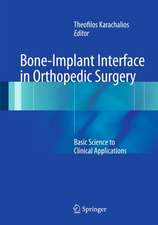Principles of Wood Science and Technology: II Wood Based Materials
Autor Franz F.P. Kollmann, E.W. Kuenzi, A.J. Stammen Limba Engleză Paperback – 19 noi 2013
Preț: 1023.42 lei
Preț vechi: 1248.08 lei
-18% Nou
Puncte Express: 1535
Preț estimativ în valută:
195.89€ • 212.86$ • 164.66£
195.89€ • 212.86$ • 164.66£
Carte tipărită la comandă
Livrare economică 21 aprilie-05 mai
Preluare comenzi: 021 569.72.76
Specificații
ISBN-13: 9783642879333
ISBN-10: 3642879330
Pagini: 716
Ilustrații: XII, 703 p.
Dimensiuni: 170 x 244 x 38 mm
Greutate: 1.12 kg
Ediția:Softcover reprint of the original 1st ed. 1975
Editura: Springer Berlin, Heidelberg
Colecția Springer
Locul publicării:Berlin, Heidelberg, Germany
ISBN-10: 3642879330
Pagini: 716
Ilustrații: XII, 703 p.
Dimensiuni: 170 x 244 x 38 mm
Greutate: 1.12 kg
Ediția:Softcover reprint of the original 1st ed. 1975
Editura: Springer Berlin, Heidelberg
Colecția Springer
Locul publicării:Berlin, Heidelberg, Germany
Public țintă
Professional/practitionerCuprins
1. Adhesion and Adhesives for Wood.- 1.0 General Considerations about Gluing.- 1.1 Physical-Chemical Principles of Gluing.- 1.1.1 Cohesion and Adhesion.- 1.1.2 Intermolecular Forces, Polarity.- 1.1.3 Influence of Temperature, Concentration and Amount of Polymerization.- 1.1.4 Influence of pH Value on the Hardening of Glue Joints.- 1.1.5 Colloidal State of Wood Glues, Sols and Gels.- 1.1.6 Rheology of Glues.- 1.1.7 Phenomena of Hardening.- 1.1.8 Fortifying (Upgrading), Filling, Extending of Glues for Wood.- 1.2 Strength Improvement and Stresses in Glue Joints.- 1.3 Testing of Glue Joints.- 1.4 Summarized Results of Tests for Various Glues.- 1.5 Effect of Wood Species and Moisture Content on the Strength of Glue Joints.- 1.6 Pretreatment of Wood Prior to Gluing.- 1.7 Glue Spreading.- 1.8 Pressing of Glued Parts and of Laminated Wood.- 1.9 Difficulties and Defects in Gluing 2S.- 1.10 Natural Glues.- 1.10.1 Starches, Dextrins and Natural Gums.- 1.10.2 Protein Glues.- 1.10.2.1 Animal Glues, Manufactured from Hide, Sinews, Bones.- 1.10.2.2 Casein Glues.- 1.10.2.3 Blood Albumin Glues.- 1.10.2.4 Soyahean (or Soybean) Glues and Peanut-Meal Glues.- 1.10.3 Shellac.- 1.10.4 Asphalt (Bitumen) and Mastic.- 1.10.5 Natural and Synthetic Rubber (Neoprene).- 1.10.6 Glues on Cellulose Basis.- 1.10.6.1 Cellulose Acetates.- 1.10.6.2 Cellulose Esters.- 1.10.7 Silicate of Soda.- 1.11 Synthetic Glues.- 1.11.0 General Considerations.- 1.11.1 Phenol-Formaldehyde Resin Glue.- 1.11.1.1 History of Phenolic Resin Glues.- 1.11.1.2 Manufacture and Chemistry of Phenol-Formaldehyde Resins.- 1.11.1.3 Application of Phenolic Resin Glues.- 1.11.1.4 Properties of Phenolic Resin Glue Joints.- 1.11.2 Resorei nol -Formaldehyde Adhesives.- 1.11.3 Urea-Formaldehyde Resin Adhesives.- 1.11.3.1 History of Urea Resin Glues.- 1.11.3.2 Manufacture and Chemistry of Urea-Formaldehyde Glues.- 1.11.3.3 Hardening of Urea-Formaldehyde Resins.- 1.11.4 Melamine-Formaldehyde Resin Adhesives.- 1.11.4.1 History, Chemistry, and Manufacture of Melamine-Formaldehyde Adhesives.- 1.11.4.2 Application of Melamine-Formaldehyde Adhesives.- 1.11.4.3 Hardening of Melamine Adhesives.- 1.11.4.4 Properties of Melamine-Formaldehyde Resin Glue Joints.- 1.11.4.5 Fortifying or Upgrading of Urea Adhesives.- 1.11.4.6 Surface Coating of Wood Based Materials.- 1.11.5 Thermoplastic Resin Adhesives.- 1.11.5.1 General Properties and Manufacture.- 1.11.5.2 Cellulose Adhesives.- 1.11.5.3 Polyvinyl Acetates (PV A).- 1.11.6 Other Synthetic Organic Adhesives.- 1.11.6.1 Epoxy Glues.- 1.11.6.2 Polyurethane Adhesives.- Literature Cited.- 2. Solid Modified Woods.- 2.0 Introduction.- 2.1 Fundamentals of Impregnation.- 2.1.1 Flow through True Capillaries.- 2.1.2 Flow through Softwoods.- 2.1.2.1 Structure Involved.- 2.1.2.2 Permeability to Liquids and Gases.- 2.1.2.3 Longitudinal versus Transverse Flow.- 2.1.2.4 Mean Pit Membrane Pore Numbers and Radii.- 2.1.2.5 Effect of Gas-Liquid Interphases.- 2.1.3 Diffusion in Wood.- 2.2 Treating Methods.- 2.2.1 Sap Displacement.- 2.2.2 Capillary Absorption and/or Diffusion.- 2.2.3 Pressure Methods.- 2.3 Wood Preservation against Attack by Organisms.- 2.3.1 General.- 2.3.2 New and Modified Treating Methods.- 2.3.2.1 Double Diffusion.- 2.3.2.2 Modified Boucherie Process.- 2.3.2.3 Predrying Methods.- 2.3.2.4 Cellon Process.- 2.4 Wood Preservation against Fire.- 2.4.1 Fire Hazards.- 2.4.2 Fire Retardant Treatment.- 2.5 Dimensional Stabilization.- 2.5.1 Cross-Laminating.- 2.5.2 External Coatings.- 2.5.3 Internal Coatings.- 2.5.4 Reduction in Hygroscopicity.- 2.5.4.1 Heat Stabilization.- 2.5.5 Cross-Linking.- 2.5.6 Bulking Treatments.- 2.5.6.1 Salt Treatments.- 2.5.6.2 Sugar Treatment.- 2.5.6.3 Polyethylene Glycol Treatment.- 2.5.6.4 Wax Treatment.- 2.5.6.5 Phenolic Resin Treatment (Impreg).- 2.5.6.5.1 Treating Processes.- 2.5.6.5.2 Properties of Impreg.- 2.5.6.5.3 Uses for Impreg.- 2.5.6.6 Vinyl Resin Treatment.- 2.5.6.6.1 Strength Properties.- 2.5.6.7 Acetylated Wood.- 2.5.6.8 Other Treatments.- 2.6 Densified Wood.- 2.6.1 Densifying by Impregnation.- 2.6.1.1 Metalized Wood.- 2.6.2 Densifying by Compression.- 2.6.2.1 Plasticizing Wood.- 2.6.2.1.1 Bending Wood.- 2.6.2.2 Resin-Treated Compressed Wood (Compreg).- 2.6.2.2.1 Making Compreg.- 2.6.2.2.2 Properties and Uses of Compreg.- 2.6.2.3 Stable Untreated Compressed Wood (Staypak).- Literature Cited.- 3. Veneer, Plywood and Laminates.- 3.1 Introduction.- 3.1.1 History, Status and Trends in Germany and North America.- 3.1.2 World Production and Analysis of Consumption.- 3.2 Veneer.- 3.2.1 Wood Species.- 3.2.2 Pretreatment of Logs Prior to Slicing and Peeling.- 3.2.2.1 Protection of Logs against Decay and Checking.- 3.2.2.2 Steaming and Boiling (Cooking) of Round Logs.- 3.2.2.3 Debarking or Cleaning.- 3.2.3 Veneer Sawing.- 3.2.3.1 Introduction.- 3.2.3.2 Circular Sawing of Veneer.- 3.2.3.3 Band Sawing of Veneer.- 3.2.3.4 Horizontal Gang Saws for Veneer Manufacturing.- 3.2.4 Veneer Slicing.- 3.2.4.1 Introduction.- 3.2.4.2 Horizontal Slicing of Veneer.- 3.2.4.3 Vertical Slicing of Veneer.- 3.2.5 Veneer Rotary-Peeling.- 3.2.6 Veneer Handling from the Slicer or Lathe.- 3.2.7 Trimming and Clipping.- 3.2.8 Veneer Peeling Lines.- 3.2.9 Veneer Drying.- 3.2.9.1 Introduction.- 3.2.9.2 Types of Veneer Dryers, Conventional Drying Times.- 3.2.9.3 Physics of Veneer Drying.- 3.3 Plywood.- 3.3.0 General Considerations.- 3.3.1 Principles of Manufacture.- 3.3.1.1 Veneer Jointing and Repairing.- 3.3.1.2 Applying the Adhesive.- 3.3.1.3 Pressing.- 3.3.1.4 Conditioning.- 3.3.1.5 Panel Finishing (Sizing and Thicknessing).- 3.3.1.5.1 Sizing or Trimming.- 3.3.1.5.2 Thicknessing (Sanding or Scraping).- 3.4 Properties of Plywood.- 3.4.0 Preamble.- 3.4.1 Density, Weight per Unit Area.- 3.4.2 Moisture Content, Absorption and Swelling.- 3.4.3 Thermal Conductivity, Acoustical Properties.- 3.4.4 Mechanical Properties.- 3.4.4.1 Elasticity and Rigidity.- 3.4.4.2 Strength Properties.- 3.4.4.2.0 General Considerations.- 3.4.4.2.1 Tensile Strength.- 3.4.4.2.2 Compressive Strength.- 3.4.4.2.3 Bending Strength.- 3.4.4.2.4 Shear Strength.- 3.4.4.2.5 Hardness.- 3.4.5 Technological Properties.- 3.4.6 Resistance against Destruction.- Literature Cited.- 4. Sandwich Composites.- 4.0 Introduction.- 4.1 Basic Design Principles.- 4.1.1 Sandwich Bending Stiffness.- 4.1.2 Sandwich Extensional Stiffness.- 4.1.3 Sandwich Shear Stiffness.- 4.1.4 Facing Stresses.- 4.1.5 Core Stresses.- 4.1.6 Minimum Weight Sandwich Composites.- 4.1.7 Local Failure Modes.- 4.2 Materials and Fabrication.- 4.2.1 Facings.- 4.2.2 Cores.- 4.2.3 Adhesives.- 4.2.4 Sandwich Assembly.- 4.2.5 Inspection.- 4.2.6 Test Methods.- 4.2.7 Repair.- 4.3 Structural Components.- 4.3.1 Beams.- 4.3.2 Columns.- 4.3.3 Plates.- 4.3.3.1 Plates under Normal Load.- 4.3.3.2 Plates under Edge Loads.- 4.3.3.2.1 Flat Panels under Edgewise Compression or Bending.- 4.3.3.2.2 Flat Panels under Edgewise Shear.- 4.3.3.3 Combined Loads.- 4.3.4 Cylindrical Shells.- 4.3.4.1 Cylindrical Shells under External Radial Pressure.- 4.3.4.2 Cylindrical Shells under Torsion.- 4.3.4.3 Cylindrical Shells under Axial Compression or Bending.- 4.3.4.4 Cylinders of Sandwich under Combined Loads.- 4.4 Dimensional Stability.- 4.5 Durability.- Literature Cited.- 5. Particleboard.- 5.0 History of Production, Consumption and Use of Particleboard.- 5.1 Raw Materials.- 5.1.1 Wood and Other Ligno-Cellulose Materials.- 5.1.1.0 General Considerations.- 5.1.1.1 Unprocessed Forest Products.- 5.1.1.2 Industrial Wood Residues.- 5.1.1.3 Flax Shives.- 5.1.1.4 Bagasse.- 5.1.2 Adhesives.- 5.1.2.1 Urea- and Melamine-Formaldehyde Resins.- 5.1.2.2 Phenolic Resin Binders.- 5.1.2.3 General Rules for Chip Resination.- 5.1.3 Additives.- 5.1.3.1 Water Repellents.- 5.1.3.2 Extenders.- 5.1.3.3 Fungicides, Insecticides.- 5.1.3.4 Fire Retardants.- 5.2 General Technology.- 5.2.0 Introduction.- 5.2.1 Particle Preparation.- 5.2.1.0 General Considerations.- 5.2.1.1 Wood Yard, Conveying of Raw Wood, Metal Detection.- 5.2.1.2 Moisture Content.- 5.2.1.3 Barking (Debarking).- 5.2.1.4 Reduction of Wood.- 5.2.1.4.1 Crosscutting, Splitting.- 5.2.1.4.2 Primary Reduction, Knife Hogs.- 5.2.1.4.3 Secondary Reduction, Hammer-Mill Hogs, Toothed Disk-Mills, Impact Disk-mills.- 5.2.1.4.4 Shaving or Flake Production, Disk Type Chippers, Cutter Spindle and Cutter Cylinder (Cutter Head) Chippers.- 5.2.1.4.5 After-Reduction.- 5.2.1.4.6 Summary.- 5.2.2 Drying of Chips.- 5.2.2.0 General Considerations.- 5.2.2.1 Dryer Types.- 5.2.3 Size Separation (Classifying) by Screening or Sifting.- 5.2.4 Conveying of Chips.- 5.2.5 Storage of Chips (Wet and Dry Bins or Silos).- 5.2.5.0 General Considerations.- 5.2.5.1 Horizontal Storage Bins.- 5.2.5.2 Vertical Storage Bins.- 5.2.5.3 Rotating Storage Bins.- 5.2.6 Dosing (Weighing and. Volumetric Dosing).- 5.2.7 Chip Blending.- 5.2.7.0 General Considerations.- 5.2.7.1 Batch Operation.- 5.2.7.2 Continuous Operation.- 5.2.8 Mat-Laying (Chip-Spreading).- 5.2.8.0 General Considerations.- 5.2.8.1 Distribution of the Particles, Manually or by Auxiliary Devices.- 5.2.8.2 Terms, Failures, Volumetric and Gravimetric Dosing of the Material.- 5.2.8.3 Spreading Machines and Spreader Heads.- 5.2.8.4 Resultant Mat.- 5.2.9 Prepressing, Wetting, Flat Pressing (Presses and Associated Equipment), Methods of Operation.- 5.2.9.0 General Considerations.- 5.2.9.1 Prepressing.- 5.2.9.2 Single and Multi-Daylight Presses.- 5.2.9.2.0 General Considerations.- 5.2.9.2.1 Relative Investment Costs.- 5.2.9.2.2 Technological Aspects.- 5.2.9.2.3 Effect of Chip Moisture Content.- 5.2.9.2.4 Effect of Press Platen Temperature.- 5.2.9.2.5 Effect of Curing Time on Physical Properties of Particleboard.- 5.2.9.2.6 Influence of Quantity of Hardener and Proportion of Formaldehyde in the Urea Resin on Quality of Particleboard.- 5.2.9.2.7 Other Technological Aspects.- 5.2.9.3 Caulless Pressing Systems.- 5.2.9.3.0 General Considerations.- 5.2.9.3.1 Tray-Belt Molding System.- 5.2.9.3.2 Tablet System.- 5.2.9.3.3 Continuous Belt System.- 5.2.9.3.4 Calender Particleboard Process; System Mende-Bison.- 5.2.10 Board Finishing (Sizing and Sanding or Thicknessing).- 5.2.10.0 General Considerations.- 5.2.10.1 Sizing.- 5.2.10.2 Sanding.- 5.2.11 Particleboard — Plastic Combinations, Printing on Particleboard.- 5.2.11.0 General Considerations.- 5.2.11.1 Types of Laminates for Particleboard.- 5.2.11.2 Structure, Manufacture, and Testing of Laminated Particleboard.- 5.2.11.3 Printing on Particleboard.- 5.2.12 Extruded Particleboard.- 5.2.12.0 General Considerations.- 5.2.12.1 Vertical Extruders.- 5.2.12.2 Horizontal Extruders.- 5.2.13 Molded Particle Products.- 5.2.13.0 General Considerations.- 5.2.13.1 Thermodyn Process.- 5.2.13.2 Collipress Process.- 5.2.13.3 Werzalit Process.- 5.3 Some Additional Layouts.- 5.4 Properties of Particleboard.- 5.4.0 General Considerations.- 5.4.1 Factors Affecting the Properties of Particleboard.- 5.4.2 Testing of Particleboard, Standards.- 5.4.3 Density, Weight per Unit Area.- 5.4.4 Moisture Content, Absorption and Swelling.- 5.4.5 Thermal Conductivity.- 5.4.6 Acoustical Properties.- 5.4.7 Mechanical Properties.- 5.4.7.0 General Considerations.- 5.4.7.1 Theoretical Approach to Particleboard Mechanics.- 5.4.7.2 Elasticity and Rigidity.- 5.4.7.3 Tensile Strength.- 5.4.7.3.1 Tensile Strength, Parallel to Board Plane.- 5.4.7.3.2 Tensile Strength Perpendicular to Board Plane, Face Strength.- 5.4.7.4 Compressive Strength.- 5.4.7.5 Bending Strength, Creep, Fatigue.- 5.4.7.5.1 Bending Strength, Modulus of Rupture.- 5.4.7.5.2 Deflection, Modulus of Elasticity.- 5.4.7.5.3 Creep, Relaxation.- 5.4.7.5.4 Fatigue, Endurance.- 5.4.7.6 Impact Strength, Punetural Resistance.- 5.4.7.7 Shear Strength.- 5.4.7.7.0 General Considerations.- 5.4.7.7.1 Compression-Shear Tests.- 5.4.7.7.2 Tension-Shear Tests.- 5.4.7.7.3 Torsion-Shear Tests.- 5.4.7.8 Hardness.- 5.4.8 Technological Properties.- 5.4.8.0 General Considerations.- 5.4.8.1 Surface Quality.- 5.4.8.2 Accuracy of Dimensions, Surface Texture and Stability.- 5.4.8.3 Machining Properties.- 5.4.8.4 Nail-Holding and Screw-Holding Ability.- 5.4.8.4.1 Nails.- 5.4.8.4.2 Screws.- 5.4.9 Resistance to Destruction.- 5.4.9.1 Abrasion (Wear) Resistance.- 5.4.9.2 Resistance to Biological Attack.- 5.4.9.2.1 Fungi (Decay).- 5.4.9.2.2 Insects, Termites.- 5.4.9.3 Reaction to Fire.- 5.4.9.3.0 General Considerations.- 5.4.9.3.1 Aspects of Tests.- 5.4.9.3.2 Wood and Wood Based Panels in Fire.- Literature Cited.- 6. Fiberboard.- 6.0 Types of Fiberboard.- 6.1 History and Development.- 6.2 General Outline of Processes.- 6.3 Raw Materials.- 6.3.1 Wood.- 6.3.2 Bark.- 6.3.3 Modified Wood Raw Materials.- 6.3.4 Non-Wood Fibrous Raw Materials.- 6.4 Storage of Raw Material.- 6.5 Raw Material Preparation.- 6.5.1 Debarking of Wood.- 6.5.2 Chipping, Magnetic Separating, Screening.- 6.5.3 Storing.- 6.5.4 Wetting.- 6.6 Pulping (Wet Processes).- 6.6.1 Mechanical Pulping.- 6.6.2 Chemical-Mechanical Pulping.- 6.6.3 Thermal-Mechanical Pulping.- 6.6.3.1 General Considerations.- 6.6.3.2 Asplund Process (Defribrator Method).- 6.6.4 Explosion Process.- 6.7 Manufacture of Insulation Board.- 6.7.1 Sizing.- 6.7.2 Mat or Sheet Formation.- 6.7.3 Drying.- 6.7.4 Additional Processing Operations.- 6.8 Manufacture of Hardboard.- 6.8.1 Sizing.- 6.8.2 Mat or Sheet Formation.- 6.8.2.1 Wet Felting.- 6.8.2.2 Air Felting.- 6.8.3 Hot Pressing.- 6.8.4 Heat Treatment and Oil Tempering.- 6.8.5 Humidification and Conditioning.- 6.8.6 Trimming and Additional Processing.- 6.8.7 Losses and Yield in Manufacture, Production Costs.- 6.8.8 Special Fiberboards.- 6.9 Properties of Fiberboard.- 6.9.0 General Considerations, Tests, Uses.- 6.9.1 Density, Weight per Unit Area.- 6.9.2 Moisture Content, Absorption and Swelling.- 6.9.3 Thermal Conductivity.- 6.9.4 Acoustical Properties.- 6.9.5 Mechanical Properties.- 6.9.5.0 General Considerations.- 6.9.5.1 Elasticity.- 6.9.5.2 Bending Strength, Creep, Fatigue.- 6.9.5.2.1 Bending Strength or Modulus of Rupture.- 6.9.5.2.2 Creep and Relaxation.- 6.9.5.2.3 Fatigue, Endurance.- 6.9.5.3 Impact Strength, Puncture Resistance.- 6.9.5.4 Tensile Strength.- 6.9.5.5 Compressive Strength.- 6.9.5.6 Shear Strength (Delamination).- 6.9.5.7 Hardness.- 6.9.6 Technological Properties.- 6.9.6.0 General Considerations.- 6.9.6.1 Surface Quality.- 6.9.6.2 Accuracy of Dimensions, Surface Texture and Stability.- 6.9.6.3 Working, Machining, Moldability of Hardboard.- 6.9.6.4 Nail- and Screw-Holding Ability.- 6.9.7 Resistance to Deterioration.- 6.9.7.1 Abrasion (Wear) Resistance.- 6.9.7.2 Resistance to Biological Attacks.- 6.9.7.3 Behavior in Fire.- Literature Cited.- Conversion Factors.- Author Index.












